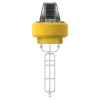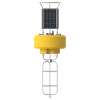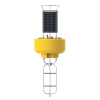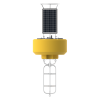Garmin GPS 24xd HVS Marine GNSS Receiver
Features
- Provides access to GPS, Galileo, GLONASS and BeiDou satellite systems
- Accurate to <1 meter CEP, <3 meters 95%
- IPX7 waterproof sensor with pole and flush mount options
- Free ground shipping
- Expedited repair and warranty service
- Lifetime technical support
- More
GPS 24xd HVS
The highly accurate GPS 24xd HVS position receiver/antenna provides up to 10 Hz update rates for position, velocity and time data. It offers high-sensitivity reception and enhanced position acquisition to the Garmin family of marine instruments, autopilots and multifunction displays.
Delivers Precise Location Data
This receiver is capable of tracking multiple global navigation satellite systems, including GPS, Galileo, GLONASS and BeiDou. Since more satellites are visible, it can provide more accurate fixes in challenging conditions. WAAS-capable, it can determine precise location to within <1 meter CEP, <3 meters 95%.
Observable Advantages
Compared to units with slower update rates, the GPS 24xd offers dramatic improvement when used at low speeds. Position and course information from slower units can jitter and swing considerably at speeds below 1 mph. The GPS 24xd provides a consistent and smooth heading which is especially important when trying to hit a specific waypoint or mark.
Built for Versatility
Part of the Garmin marine instrument family, the GPS 24xd HVS is built to withstand the elements. This waterproof (IPX7) sensor can be pole mounted or flush mounted. It also can be attached to the underside of many fiberglass decks for added ease of installation. In addition, it also can be configured to have 1 Hz or 5 Hz update rates to help support specific installation requirements.
- Dimensions (D x H): 3 19/32" x 1 15/16" (91.6 mm x 49.5 mm)
- Weight: 7.1 oz (201 g)
- Cable length: 30 ft (9.14 m)
- Temperature range: -22° to 176° F (-30° to 80° C)
- Case material: Fully gasketed, high-impact plastic alloy; waterproof to IPX7
- Compass-safe distance: .5" (12.7 mm)
- Power source input: 8-32V, unregulated
- Input current: 150 mA at 12 Vdc
- Position accuracy, typical marine use: < 50 cm, CEP 50%; < 1.0 meter, 88%
- GPS 24xd HVS
- Pole mount
- Surface mount
- Under deck mount
- Power/data cable
- Update rate select cable
- Documentation
In The News
Combating Water Insecurity in Saskatchewan with Real-Time Data
The prairies of Saskatchewan can be described as one of the least water-secure parts of Canada, making water quality monitoring essential for informed resource management in a region already facing water insecurity. While natural physical properties worsen some of the poor water quality conditions in the region, others are connected to land use. Having grown up spending summers on the shores of Lake Huron, Helen Baulch, an associate professor at the School of Environment and Sustainability at the University of Saskatchewan , has always been dedicated to the protection of water resources. Looking back fondly at her childhood playing along the shore, Baulch also recalls the invasion of quagga mussels during her teenage years and watching the lake change as a result.
Read MoreSeametrics Turbo Turbidity Logger: Boost your Turbidity Monitoring
The Seametrics Turbo Turbidity Logger is a self-cleaning turbidity sensor capable of internally logging over 260,000 data records. The sensor enables researchers, compliance officers, and contractors to monitor turbidity in various applications, from construction and dredging sites to wastewater effluent. Due to its narrow width, this device can be deployed in a range of areas, from small well spaces to rivers and streams. The stainless steel housing and built-in wiper allow the sensor to withstand long-term deployments and reduce the need for maintenance trips. The logger accurately records temperature and turbidity up to a depth of 50 meters.
Read MoreCollecting Data at the Top of the World: How Scientists Retrieve Glacial Ice Cores
A helicopter touches down in the small town of Sicuani, Peru, at an elevation of 11,644 feet. Earlier that day, a boxcar brought fuel, drills, food, and other equipment for a glacial expedition. The year is 1979, and glaciologist Lonnie Thompson is preparing to lead a team to the Quelccaya ice cap in hopes of becoming the first scientists to drill an ice core sample from this glacier. The only problem? The glacier is located at 19,000 feet in one of the most remote areas of the world. The helicopter takes off from the town, but the thin atmosphere at that elevation does not allow it to safely touch down on the ice– due to the aircraft’s weight, and it becomes unstable when the air is less dense.
Read More

















